Army War College Report Predicts Mass Casualties in Near-Peer Fight Against [Russia] - Analysis
A few weeks ago the U.S. Army War College released a paper which was an urgent call for the U.S. armed forces to adapt to the modern style of warfare being innovated in the Ukrainian conflict.
The paper made the rounds due to some startling admissions, which we’ll get to. But what’s most important to understand is that it represents a general shift in thinking that’s propagating throughout the entire sphere of the Atlanticist West, and was released in concert with several other key thinktank pieces and policy shift announcements from the EU, NATO, etc., which holistically represent an internal panic deep within their structures, resulting in an urgent need for a strategy change.
And this point is one of the central themes of the War College paper itself. Its opening preamble can be summarized in a single sentence: the current time period marked by the Ukrainian conflict represents the largest “inflection point” in 50 years of military history. The authors believe that the Yom Kippur War of 1973 was the previous most impactful inflection point. They recount how the U.S. army was demoralized by its experience in Vietnam, and inability to meet its objectives, followed by Israel almost losing to a Soviet-equipped Egypt in the Yom Kippur War.
As a very brief and over-generalized backdrop, though Israel is listed as officially having “won” the Yom Kippur War, Egypt in fact achieved most of its political objectives, which was to seize some land east of the Suez in order to eventually take back the Sinai peninsula, which they did. And although Egypt made huge blunders that caused part of their army to be routed, ultimately the war proved to Israel, the U.S., and allies that the future would be dangerous as the Arabs were getting much stronger, particularly under Soviet backing. In fact, for anyone interested, just purely coincidentally there’s a new article from a week ago in the Jerusalem Post about the irony that years later, Israel views the Yom Kippur War as a somber experience whereas in Egypt it’s celebrated as a grand victory.
Either way, the War College explains that as a result of this inflection period, the U.S. founded TRADOC (United States Army Training and Doctrine Command) school. Which is actually a network of schools tasked with creating new operational doctrines to prepare the U.S. military for future conflicts. In short, they were spooked by the developments of the previous years, and needed a way to “jump ahead” of the competition. This resulted in a series of new doctrines like the AirLand Battle I wrote about at length in this previous dissection of a U.S. internal thinkpiece:
Dissecting West Point Think-tank's New Analysis of Russia's Military Evolution
The Modern War Institute at West Point—a sort of think tank chaired by Mark Esper and which is a part of the Department of Military Instruction—released a very interesting in-depth analysis of Russia’s battlefield innovations in the SMO, called: THE RUSSIAN WAY OF WAR IN UKRAINE: A MILITARY APPROACH NINE DECADES IN THE MAKING.
Their point culminates as follows:
DePuy’s new organization (TRADOC) was charged with studying the Yom Kippur War to develop concepts, drive procurement and materiel changes, and prepare the Army to fight a modern war.
Secretary of Defense James R. Schlesinger, Abrams, and DePuy recognized that the Army was at a critical juncture and that only a monumental shift could prepare the force for the changing character of war. It would be 50 years before the next great inflection point suggesting the need for doctrine and materiel changes emerged.
Fifty years later, the Army faces a new strategic inflection point, a choice to alter the fundamental way the US Army prepares for the next fight. As the Defense establishment emerges from 20 years of counterinsurgency operations and begins to embrace a future of large-scale combat operations, the ongoing Russo-Ukrainian conflict brings the changing character of warfare into sharp relief—a future of warfare marked by advanced autonomous weapons systems, artificial intelligence, and a casualty rate the United States has not experienced since World War II.
They go on to state that the war has been a wake up call for the army, which requires a major ‘culture change’ in order to fully internalize and embrace the battlefield developments being witnessed. And in fact, this War College report comes at the request of and under the auspices of TRADOC.
The general gist of their chief point of concern is something we’ve all known, and something I’ve continuously written about, including in the previously posted report. It’s the fact that the past two decades of U.S. military action abroad have been nothing more than glorified policing actions against insurgent threats, dealing primarily with COIN (Counter Insurgency) training, tactics, and general strategic doctrine.
They now understand that years of fighting in a way where signal dominance and air supremacy reigned, allowed the U.S. to become undisciplined and lax, never having to worry about being ‘contested’ in any domain. This is the same point made by Dr. Philip Karber’s West Point Talk, where he repeatedly emphasized how bright the U.S. army’s rear logistical and C2/C3 points “glow” in the electromagnetic spectrum, and how easily this would be seen and pinpointed by Russia or any advanced peer force.
The Russia-Ukraine War makes it clear that the electromagnetic signature emitted from the command posts of the past 20 years cannot survive against the pace and precision of an adversary who possesses sensor-based technologies, electronic warfare, and unmanned aerial systems or has access to satellite imagery.
The paper reveals that at the moment Ukrainian battalion command posts reportedly consist of only seven soldiers who dig in and change positions twice daily.
Another complementary new report corroborates this:
Quoting JRTC’s (Joint Readiness Training Center) Brigadier General David Gardner, this article states:
In turn, Army formations are learning to adjust, including by using their communications equipment as little as possible. “In the past, it was only scouts that would go into radio silence, ” Gardner said. “Now we're seeing that across entire formations.”
Formations are also adapting by changing up their communications—using parabolic antennas to direct radio waves, using fiber-optic cables, and trying to match the pattern of other signals traffic in the area so as to not stand out, Taylor said.
Gardner’s chief point of concern about the modern battlefield is the completely “transparent nature” of it—nothing you do can truly be concealed, at least not with any measure of ease and not without great disproportionate effort.
Turning back to the War College report, we now come to the most eye-opening part which has been making the rounds across the internet. The stark admission that facing such an unprecedented high-intensity war as the Ukrainian conflict, the U.S. can expect to suffer 3,600 casualties per day:
For context, the United States sustained about 50,000 casualties in two decades of fighting in Iraq and Afghanistan. In large-scale combat operations, the United States could experience that same number of casualties in two weeks.
Firstly, this seems an interesting admission of what they likely believe Ukraine’s true daily casualty rate to be, including all total wounded. But perhaps also an admission that the U.S. can end up suffering even higher casualties because they don’t currently have the capability to disperse and de-centralize with the efficacy that Ukraine manages. Not to mention a general understanding that in a war between U.S. and Russia, the latter would not be fighting with ‘kid gloves’ in the way it’s currently doing with Ukraine, which it views as a fraternal brother war and has certain mission priorities to reduce civilian casualties and infrastructure damage in a land it intends to occupy and annex afterwards. All of that would go out the window against the U.S. or NATO.
But put that in perspective. That’s the official Army War College admitting that against Russia, they would suffer in a single day more casualties than they suffered in the entirety of the twenty-year-long Afghan war (2001-2021). This should tell you how profoundly disturbed U.S. planners secretly have been by Russia’s capabilities in the Ukrainian conflict.
In a mere two weeks, the U.S. can suffer 50k casualties, according to the report. But the biggest issue here is they foresee a need of 800 daily recruits to sustain such a war, yet they call attention to major deficiencies in the current reserve system:
The Individual Ready Reserve, which stood at 700,000 in 1973 and 450,000 in 1994, now stands at 76,000.
It goes on:
These numbers cannot fill the existing gaps in the active force, let alone any casualty replacement or expansion during a large-scale combat operation. The implication is that the 1970s concept of an all-volunteer force has outlived its shelf life and does not align with the current operating environment. The technological revolution described below suggests this force has reached obsolescence. Large-scale combat operations troop requirements may well require a reconceptualization of the 1970s and 1980s volunteer force and a move toward partial conscription.
What’s most interesting is that this release comes amid a timely and clearly coordinated push from other publications to begin conditioning the U.S. public for the need of a new future draft to restock the depleted American armed forces.
Military.com first blew the horn on the need a couple months ago:
They argue that confidence in the military is at its lowest and that the branches can’t fill their yearly quotas of recruits. A “limited draft” could help them catch their numbers up. This happens to jibe with the War College report which states that:
…the US Army is facing a dire combination of a recruiting shortfall and a shrinking Individual Ready Reserve. This recruiting shortfall, nearly 50 percent in the combat arms career management fields, is a longitudinal problem. Every infantry and armor soldier we do not recruit today is a strategic mobilization asset we will not have in 2031.
In short, they are thinking toward future conflicts and have already identified that America won’t have even close to the required number of ‘bodies’ to take on a competent adversary.
But here’s the biggest bombshell of all. Those who’ve read my work know I’ve harped repeatedly on the fact that the ‘conscript vs. contract’ dichotomy is a deliberate oversimplification in the West, designed to disparage and downplay Russia’s army. But most importantly, I’ve pointed out that the “all professional” force seen as the embodiment of the Western military ideal is in fact an illusion meant only to sustain localized insurgency conflicts, and that “all professional” forces stand no chance in large scale total war scenarios.
Now, quelle surprise, the War College report agrees with the following admission:
The implication is that the 1970s concept of an all-volunteer force has outlived its shelf life and does not align with the current operating environment. The technological revolution described below suggests this force has reached obsolescence. Large-scale combat operations troop requirements may well require a reconceptualization of the 1970s and 1980s volunteer force and a move toward partial conscription.
Translation: the idea of an all volunteer/professional force is obsolete. Large scale combat operations require at least partial conscription. Anyone worth their salt in military matters would have known this long ago. How can you possibly sustain a high intensity war effort with upwards of thousands of casualties a day merely through volunteer enlistments? U.S. planners should of course know this, their last “real war”—that of Vietnam—famously employed a full-scale mandatory draft, and they still lost. Imagine fighting such a war without a draft or “conscripts”?
But the fatal problem for the U.S. now is that national pride and general morale are at their lowest, probably historically. Not to mention that the eligible population is now predominantly too sick and out of shape to even qualify for military service, requiring a constant creeping regimen of standards relaxations.
The latest numbers are not only “concerning,” they are outright catastrophic, and that’s from an official DOD report:
In fact, the Military.com article admits that the draft was abolished and replaced with the ‘all volunteer’ system in 1973 primarily due to the American public’s disgust and weariness with the Vietnam War. You can see how the propaganda pipeline works: the U.S. lost an unpopular war and was forced to change its system. Then, this system is subsequently valorized in every military publication, pop-culture representation, etc., as the “superior” one to whatever backwards system that Russia used. Yet it’s clear that the U.S. only differed from the Russian system due to lack of choice and under duress from its own public.
Other publications came to the same conclusion regarding the connection of the War College report to the recent murmurings of a potential U.S. draft reactivation:
The truth is, in many ways the U.S. armed forces are currently a lot smaller and less ready for a major conflict than most people are aware. Not just in the needed manpower and the strategic industrial capacities, which we’ve discussed at length here before, in manufacturing weapons, etc., but also even in the current available equipment.
Just as one example, without getting lost in the weeds of the details, here’s the U.S. Army’s own 2024 audit for its current land forces, revealing a shockingly paltry amount of heavy armor:
It shows a measly ~970 operable Abrams tanks, the rest are in storage. Their forces are spread over a mere 31 active brigade combat teams.
Though you may be thinking the Marines have Abrams too, but they were supposed to have given them all up to the Army several years ago after transitioning to an all amphibious force.
In fact the U.S. Army’s own Army Times paper reported on the woes last year, stating the “recruiting crisis” has shrunken the Army to what would be a mere 445,000 by October 2023, which requires a restructuring of their BCTs.
The figures break down into a mere 11 ABCT (Armor Brigade Combat Teams), each of which have 6 armored companies of about ~15 Abrams tanks each, or 87 tanks per ABCT. So 87 x 11 = 957 which roughly comports with the graphic above.
That’s extremely little for a modern war against a power like Russia which, even according to Western sources, has allegedly lost thousands of tanks and continues to operate just fine. Nor are those measly 900 Abrams tanks all the most advanced variants, either—in fact many of them are old M1A1s. Ukraine is said to have lost upwards of 400-500 tanks or more in the counteroffensive since June. That would be virtually half of the entire U.S. army’s current active armor gone in three months.
But getting back to the War College report. Given these issues, what are their prescriptions for the future? To be honest, it appears a fairly anemic list of suggestions, some of which are questionable, and none of which offer any kind of panacea. They believe that the armed forces should develop closer ties with private companies responsible for a lot of the class of warfare systems, from open-source intelligence, drones, etc. They seem to believe this sort of fusion of the private and military is integral to winning future battles simply owing to how crowd-sourced data and satellite corporations have helped Ukraine achieve ISR command in the current conflict.
Of course they ignore the myriad pitfalls and vulnerabilities of leaning too heavily into such a tempting trap. I’ve already described many of them before. The Pentagon papers proved that U.S. intelligence often relied on open source data from amateur ‘BroSinters’ often—or dare I even say usually—to their detriment. For example, using fraudulent Oryx numbers for calculating Russian losses from which strategy and policy was then sculpted. Or using the plethora of amateur OSINT accounts specializing in topographical mapping of Russia’s Surovikin line in Zaporozhye, which led to catastrophic miscalculations and underestimations of Russia’s strategic defenses.
The fact is, facing disastrous shortfalls and deficits, the U.S. armed forces has no real choice but to “out source” a lot of its future war fighting capability—whether that’s to private corporations, open source collectives on the internet, etc. One of the fatal flaws this creates is a porous system with no operational security. This fact was proven by the Pentagon leaks earlier in the year, when it was found that due to the vast amount of outside contractors required to work on the U.S. armed forces’ internal systems, it was simply impossible to create restrictions in access protocol that would totally protect the labyrinth of information pipelines.
But the Army planners want to lean into this. The entire section I just summarized was headlined as “Greater Use of Unclassified Intelligence.”
Another somewhat humorous prescription is to create an internal “manual of manuals” using “generative AI”—you know, like ChatGPT:
DePuy’s “how to fight” manuals of the past reinvented as chat platforms fueled by generative AI knowledge bases and layered on top of National Training Center rotations, division and corps warfighter exercises, and small-unit training would serve as the ultimate convergence activity.
In fact the other complementary article I quoted earlier shed light on how this is already being trained in U.S. army centers:
In one recent exercise, Taylor’s OPFOR troops used AI-language model ChatGPT to create enemy speakers on the artificial social media site the training ground uses. The AI enemy defense minister got into a tweet-war with the Army unit.
So this is their answer? Tweet wars with ChatGPT? Color me unimpressed. Although in some ways, this isn’t much different to what is already being experienced by Ukraine. A recent Le Monde article described how “disappointing” NATO instructors were forced to look up solutions “on YouTube” to help their Ukrainian charges:
🇺🇦 “Ukrainian military is disappointed with training from NATO instructors” —Le Monde
“There have been several instances where (NATO instructors) have gone to YouTube to look for solutions, especially when planning operations or resolving disagreements.”
According to one Ukrainian soldier who was trained in the West, the instructors themselves do not always know how to act in unforeseen situations.
The situation with aerial reconnaissance by drones is the most deplorable, the instructors claim that it is not included in the NATO training program, although this discipline is an integral part of the war in Ukraine.
Well, with generals like Milley leading the U.S., I suppose you might as well use ChatGPT to construct your offensive strategy in a future war—it will probably be more successful than ignorant, politicized, “woke” generals and commanders.
Of course, it just goes to show when this is who not only authored the paper, but was the “Director of Strategy and Planning at U.S. Special Operations Command Central”:
Ironically, the second author of the paper is listed as John A. Nagl, whose primary credential lists him as a world-renowned expert on ‘counter insurgency’. I think we’re starting to see the problem at the core of modern U.S. military doctrine. You have a diversity hire and a COIN-op writing your strategies of defeating the two superpowers of Russia and China. Of course this is endemic to the U.S. military and contrary to changing, will only get worse. For instance, Milley’s new replacement as top general Charles Q. Brown’s literal first public speech revolved around diversity hiring in the military. That’s on top of the fact he was already long known as being even “more woke” than Milley himself, which is saying something:
That’s not to turn the topic political, but rather to highlight that America’s military is in a terminal decline because its primary decreed focus continues to be on identity politics, satisfying quotas thereof, and other issues which should have no place in a military, or at least should not constitute the main concern of its leadership. Naturally, Russia and China are rubbing their hands in delight at their chief adversary’s complete lack of proper initiative.
The final section of the War College report reiterates the call for major shifts in learning and training from this historic “inflection point.” It believes the erstwhile AirLand Battle doctrine will now become an AI land battle doctrine thanks to what Russia has taught them:
The AirLand Battle concept derived from the Yom Kippur War (after the failed foray into Active Defense) may now morph into artificial intelligence land battle informed by the Russia-Ukraine War and a future of largely unmanned or remotely manned ground combat vehicles.
This shift interestingly mirrors what happened in the Gulf War, where it was Russia that watched the U.S. trounce Iraq in a ‘new’ and unforeseen way, which sent Russian war colleges and thinktanks scrambling to reconfigure their ideas for what future war might look like. I wrote about the ideas they concluded from that learning experience here—and most of them turned out to be highly accurate to today’s conflict.
Now to touch on the new Rand paper, which has to do with the theme of risk escalation in the Ukraine war. There are only a couple main points to ferret out here. The most important is Rand’s list of the 3 main types of escalation scenarios that could occur:
Again, to tie things into current events, it’s interesting they chose to focus on this area now, of all times. The reason being that just yesterday, Britain made waves by asserting that they will send ‘advisors to Ukraine’. Now, as if in another concerted timed release, Rand is discussing what would happen if Russia kills NATO officials inside of Ukraine.
It’s also odd timing given Medvedev’s recent statements, which themselves follow a major provocation from Germany vis a vis the Taurus missile, that Russia would be legally permitted to strike German facilities outside of Ukraine in exchange for Germany’s position that Ukraine can use the Taurus missiles to strike targets inside Russia proper.
You see, usually such provocation chains are heavily planned out and orchestrated by the West, as the entire Ukrainian war was to begin with. That’s because knowing a country’s pressure points and their stated doctrinal reactions to those points, and then acting on them to provoke the country into doing exactly what you want it to do, is very elementary.
We’ve talked for a long time about how when Ukraine is finally on the precipice of total capitulation, there will be a dangerous period of heightened risk for a major falseflag from the West to save them. Thus, given the timing, and that Ukraine now does appear to be entering a declining phase, the Rand report strikes me as almost prescriptive in nature, i.e. a subtle ‘nudge’ to clandestine policymakers to begin a phase of operations that could provoke and goad Russia into creating a needed “overreaction” which would set the stage for some form of intervention to save Ukraine.
Notice how literally each of their points are areas where they have recently begun escalating themselves. Yet here they are characterizing it in a manner of a pre-emptive excuse so as to give themselves baked-in absolution later, should things precipitate as they’ve outlined.
For instance, take #1: a Russian strike could kill NATO officials inside of Ukraine causing NATO members to trigger a “collective response.” Are they literally openly trying to give NATO members ideas as to what to do? And their own NATO member UK has just announced sending advisors to the front in a much more involved role, which would pretty much force the self-fulfillment of this prophecy.
#2: Aggressive Russian maneuvers against NATO recon planes in the Black Sea. Anyone who’s followed the conflict recently knows that particularly around the time of the big strikes on Crimea, NATO recon flights in the Black Sea have gotten particularly and exceptionally provocative. This includes an increase in numbers, closer flights to Crimea, as well as new AWACS tracks established in Lithuania and Romania, not to mention the first-time announcement that French recon planes have likewise begun participating in the Black Sea area as well.
Once again we see them seemingly advancing the self-fulling dialectic. They intentionally increase pressure on Russia in a given area in order to force an overreaction and then prefigure the consequences in a thinkpiece to later retroactively “prove” that they had foreseen Russia’s aggressive/illegal/barbaric escalations all along.
#3: Russia misperceives a NATO move as start of an intervention. Well, gee, let’s see—might Russia perhaps misperceive the literal announcement of NATO boots on the ground recently made by none other than the actual Defense Minister of the UK—one of NATO’s most consequential and powerful nuclear armed members—as the start of some kind of intervention? How can you not “misperceive” that?
Recall that in the shuffle of the UK Defense Minister’s highly provocative announcement, the most significant portion of it was overlooked. Everyone concentrated on the statement about moving boots on the ground “further east” into Ukraine rather than mere instructors in the western region. But they completely ignored the part where he announced bringing the Royal Navy into the Black Sea:
Following a trip to Kyiv last week, Mr Shapps also revealed that he had talked to Volodymyr Zelensky, the Ukrainian president, about how Britain’s Navy could play a role in defending commercial vessels from Russian attacks in the Black Sea.
So let’s summarize. The UK announces a highly provocative shift of insinuating themselves and their navy into the war, and then Rand just happens to release a new thinkpiece outlining how it’s Russia who may soon desperately “escalate” by launching unprovoked attacks on NATO troops?
It’s clear that what they’re trying to do is create a built-in excuse that would pin any future escalation’s blame on Russia.
Here’s the final chart from their report, giving all the potential escalatory dynamics they foresee:
Interestingly, buried in the extended complementary report is the admission that Russia actually has no current reason to escalate because they perfectly envision themselves as still winning the war via continued attrition:
Russia believes it still has a path to achieving its goals in Ukraine. At present, there still appears to be a perception in the Kremlin that continued mobilization and the potential to outproduce Ukraine and key NATO countries in critical munitions may enable Russia to win a long, grinding war of attrition, without taking on further risks of NATO intervention. Directly attacking NATO and hoping that the response would be a reduction in support for Ukraine rather than an increase, or even direct NATO entry into the war, would be an enormous risk for Russia to run. As long as Moscow believes it has other, plausible pathways to achieving its goals in the war, it may prefer to avoid such risks.
But this seems to highlight the odd dichotomy: on one hand the entire report, entitled Escalation in the War in Ukraine, appears to go into overdrive in attempting to convince readers and policymakers that Russia is surrounded by a plethora of escalation options, insinuating that it will have no choice but to use one of them as it gets increasingly ‘desperate’ in the war effort. But on the other hand, they admit Russia actually doesn’t see any reason to escalate.
This leaves us to conclude that the real current course in Western military command centers and thinktank-land revolves around finding further pressure points and ways to make Russia want to escalate in a way that could turn global perception against it, and could justify further NATO intervention of some kind to save Ukraine. In a sense, as I implied before, this report appears more like a handbook or guidebook on how to make Russia give us the casus belli to increase our own provocations and escalations to save a floundering AFU.
What it ultimately highlights is the fact that the West appears greatly irked and peeved by Russia’s stoic, mannered approach to this war. They are beside themselves, and can’t believe that Russia can fight such a devastatingly protracted conflict in so calm and measured a manner, without major political, societal, and economic upheaval to throw them off-kilter and create the ripe groundswell of turmoil which would necessitate an off-balancing “escalation” that would prove a major blunder, and hand the salivating NATO thinktankers an enormous gift.
Thus, in light of this, the West plans to use all possible means to coax Russia into shooting itself in the foot by disproportionately responding to one of the planned provocations they have in store, in order to give raison d’etre for some intervention to save Ukraine. This doesn’t have to be something of maximal proportions yet, like full-on NATO invasion or something like that. No, even the justification of further increased support, or the activation of more lethal strategic weaponry supplied to Ukraine would suffice.
Remember, a major portion—perhaps the biggest one—of the West’s support is convincing their own publics and lawmakers in justifying increasingly more provocative weapons pledges. Even provoking a relatively minor Russian rash response could be used to convince wearying Western populaces in warming to the hand over of things like ATACMS or other items.
Of course, I find all this to be a relatively pointless exercise and strategic dead-end because I don’t think they have much left to hand over that could do anything in changing the now-crystallized trajectory of this conflict. The only other potential pivot I could glean from the Rand document which could conceivably form the axis of a strategy is in the final item on their escalations options list: Option G.
It reads: Ukraine expands its strikes inside Russia. Motivation: Increase domestic political costs for Russian leadership.
That encapsulates just about the only realistic option they have left, and given recent trends it appears to be one of the main thrusts they’re going with. I’m referring to the other big recent provocation, German Bundestag member Marie-Agnes Strack-Zimmermann’s statement that Ukraine has the right to strike Russian territory with German Taurus missiles. Putting the two together, we can only come to the conclusion that the progressive push for Ukraine to strike deeper and deeper into Russian territory has nothing whatever to do with any strategic or military considerations, but rather revolves entirely around Rand’s assessment of “putting political pressure on Russian leadership.”
To wit, they believe that by striking deep into Russia they can cause enough fear, panic, and public distress as to force Russian citizens to begin pressuring the government to end the war, or simply create enough unpopularity as to give Western intel services opportunities to oust key leadership, whether that might be election, overthrow, etc. Unfortunately, this has virtually no chance of having any effect as the Russian public either doesn’t care nor notice any strikes, including the ones to the heart of Moscow, or is simply unified into greater solidarity by them.
Dmitry Medvedev’s “populist” pandering-style response to both the aforementioned provocative announcements likely leaves Western thinktankers with an inkling of hope:
The number of leadership idiots in NATO countries is growing.
One newfangled cretin - the British defense minister - has decided to move British training courses for Ukrainian soldiers to the territory of Ukraine itself. That is, to turn their instructors into a legal target for our Armed Forces. Realizing perfectly well that they will be ruthlessly destroyed. And not as mercenaries, but as British NATO specialists.
Another fool - the head of the Defense Committee of the Federal Republic of Germany with a hard-to-pronounce surname - demands to immediately supply the Khokhobanderites with Taurus missiles, so that the Kiev regime can strike at the territory of Russia to weaken the supply of our army. They say this is in accordance with international law. Well, in that case, strikes on German factories where these missiles are made would also be in full compliance with international law.
After all, these morons are actively pushing us towards World War III....
- Medvedev
But alas, ever the stoic practitioner of the ‘long game’, I doubt Putin will give them the uncharacteristic slipup they’re counting on to salvage their disastrous Ukrainian campaign. Painful as it might be for us to take some of the obviously deliberate provocations ‘on the cheek,’ good chance remains that sometime in the future, after Ukraine’s rapid disintegration and subsequent capitulation—perhaps even only a year or two from now—we may recognize, in hindsight, the wisdom of the strategy which staved off nuclear war by way of a methodical, unwavering, and strategically disciplined approach.
If you enjoyed the read, I would greatly appreciate if you subscribed to a monthly/yearly pledge to support my work, so that I may continue providing you with detailed, incisive reports like this one.
Alternatively, you can tip here: Tip Jar



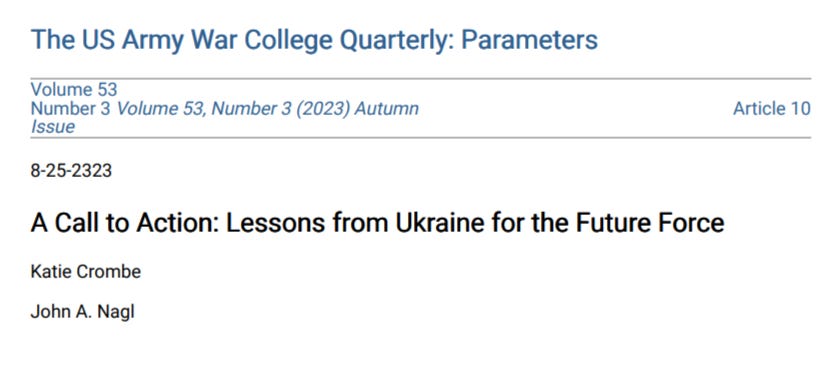

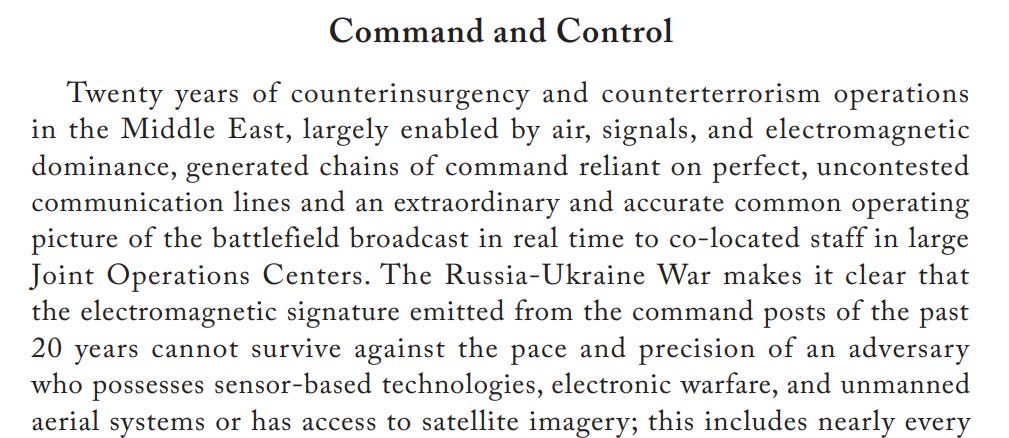
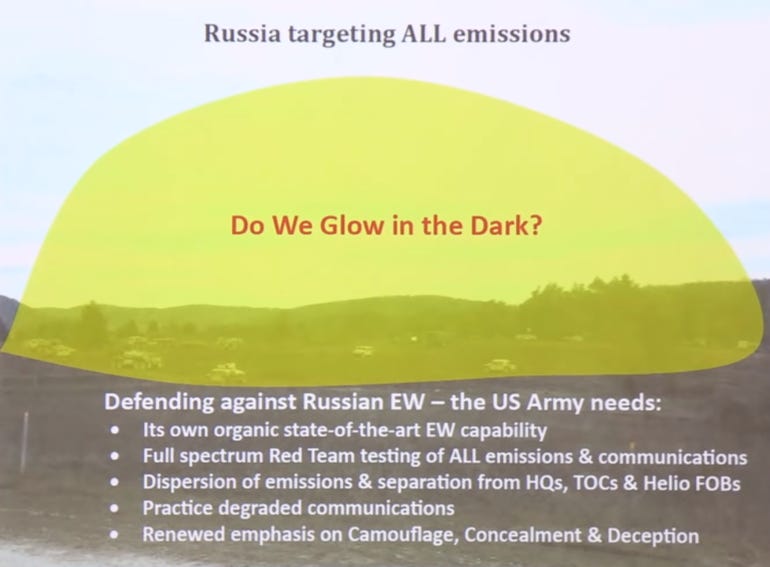

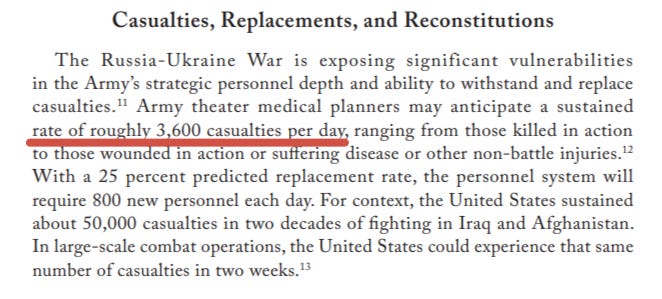

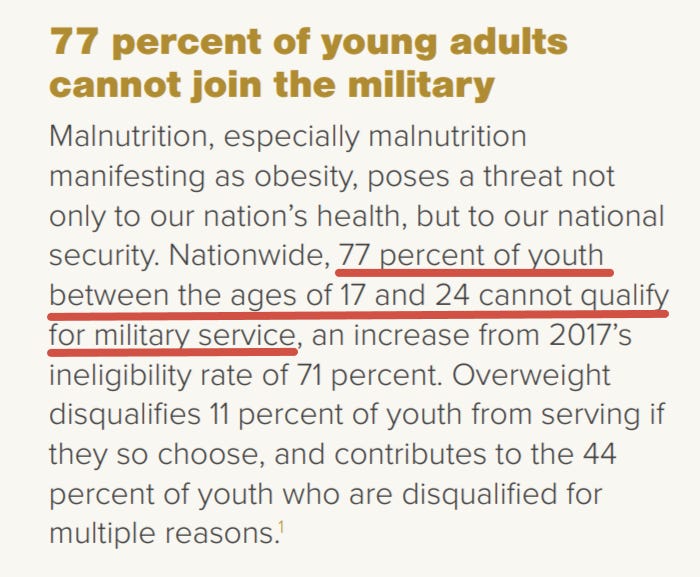
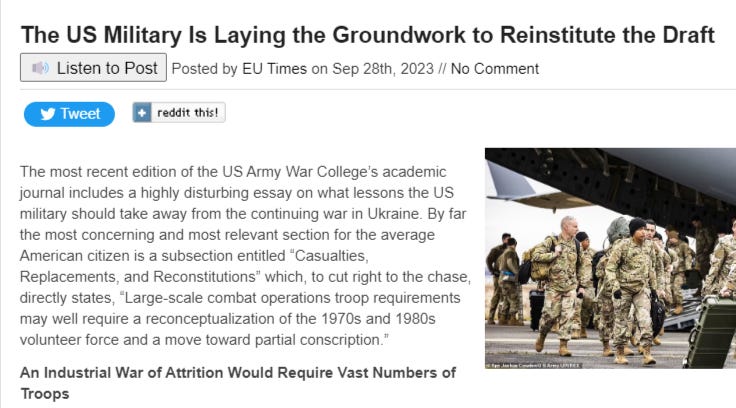

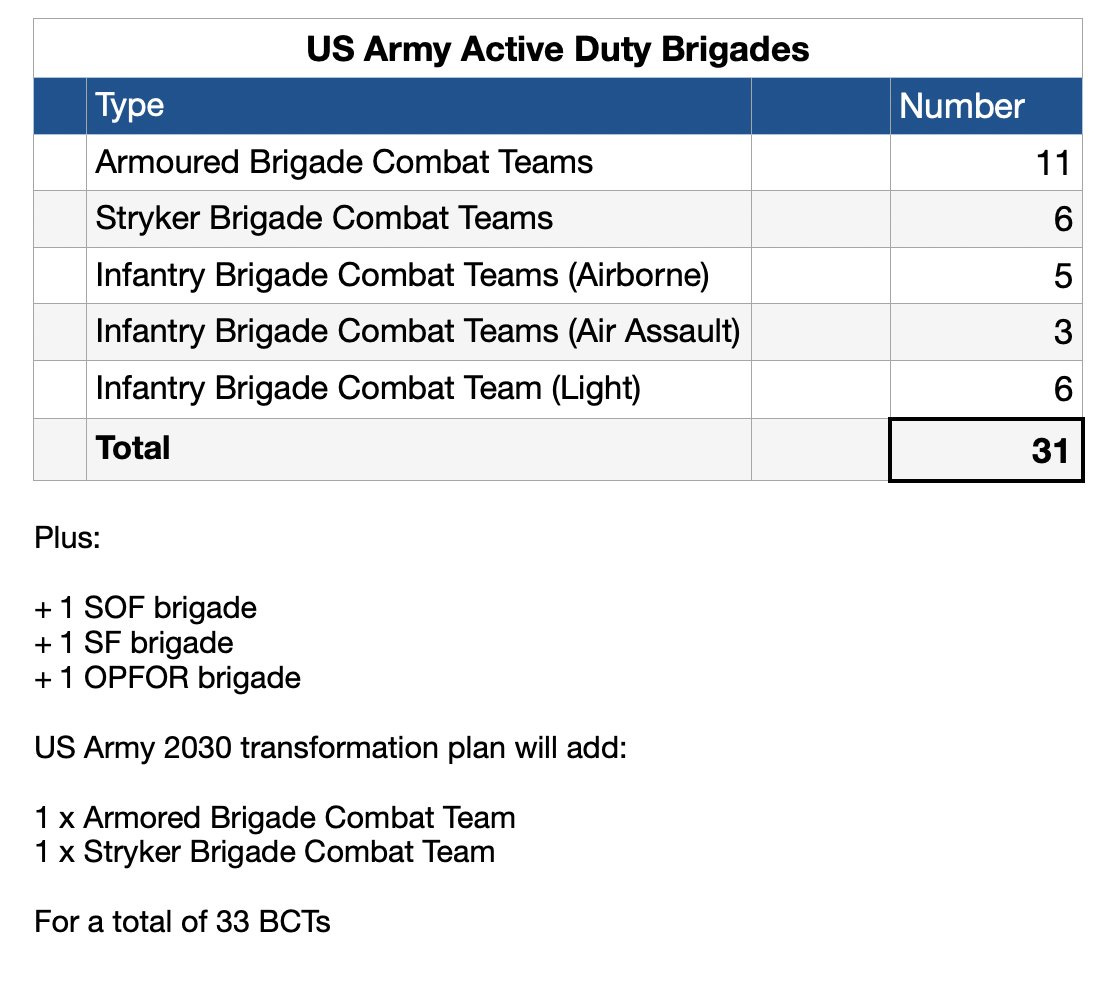





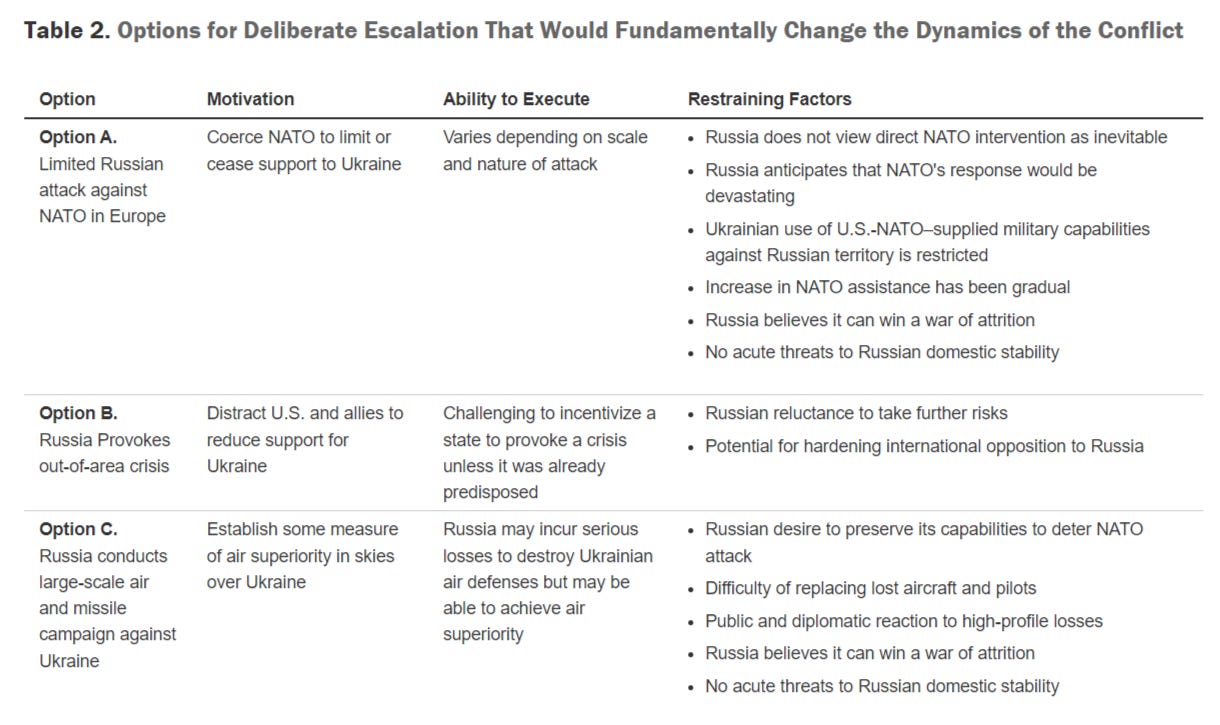
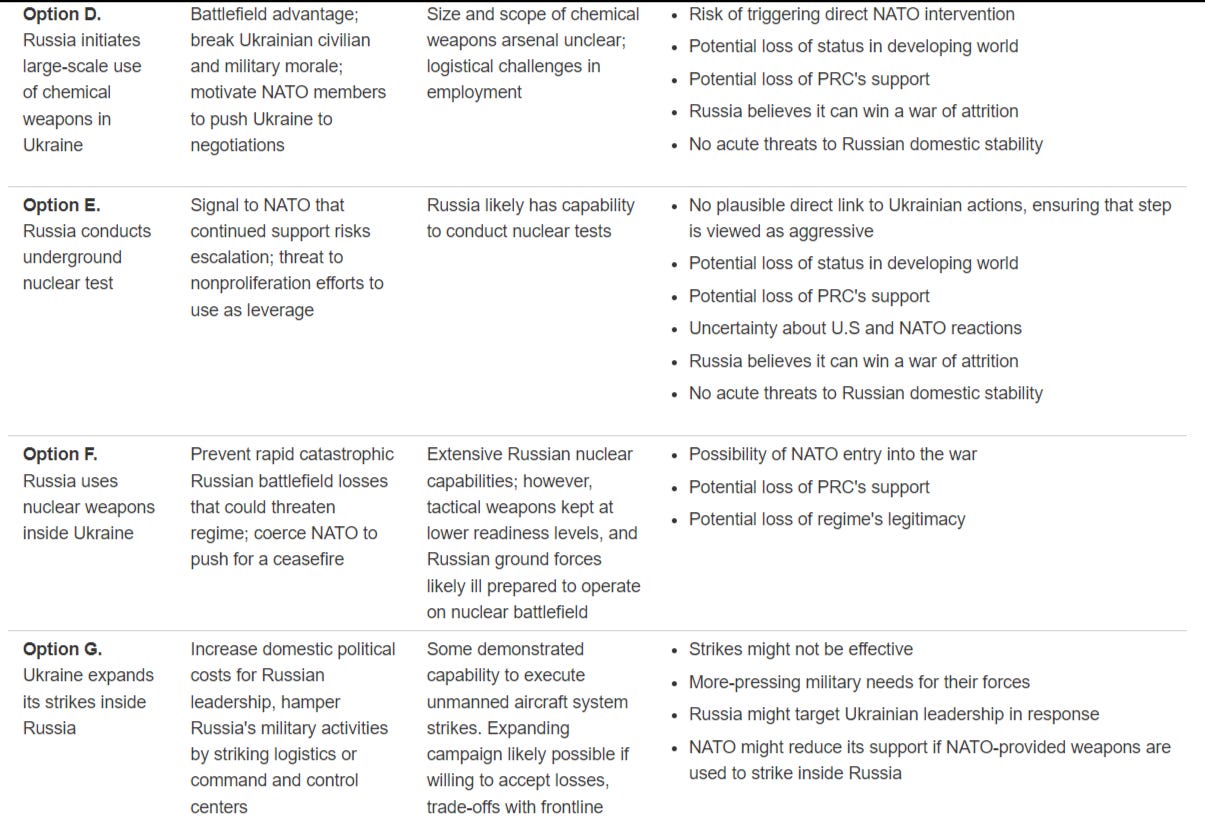
Just a bunch of blather from the Stink Tanks. The US military is kaput. Which is a good thing for the world. It's all just a clown show. There won't be a draft. Western collapse is here and accelerating. Here's a senior Pentagon official who got arrested today for running a 20-year dog fighting ring. He's black, of course. https://dailycaller.com/2023/10/02/pentagon-official-accused-abusive-dogfighting-ring-2-decades-frederick-moorefield/
Yet another insightful post.
I note that the 'Army War College' Report totally glosses over 2 critical problems that face the United States right now:
#1 Russia's game changing development of new weapons, based on secret breakthroughs in advanced physics.
Not just offensive (eg manoeuvrable hypersonics) but also defensive systems (eg lasers)..
The advantage Russia enjoys in this area is exponential. The returns accelerate the longer the competition (America) fails to understand the physics behind these weapons.
To crack this will require a genius to emerge in the United States (ie pure luck), or a revolution in the American education system, which is in ruins. Even then it's debatable whether the Americans can ever catch up.
#2 America's poor / non existent military industrial capacity. Right now America can't sustain a major war against Russia, let alone China and certainly not Russia/China combined, for more than a few weeks.
Building this capacity would take years, and would be based on fossil fuels. It would require abandoning pretty much the entire global warming/climate change project.
By failing to include these two factors, the Report is pretty much meaningless drivel, consistent with the amateurs who seem to have written it.